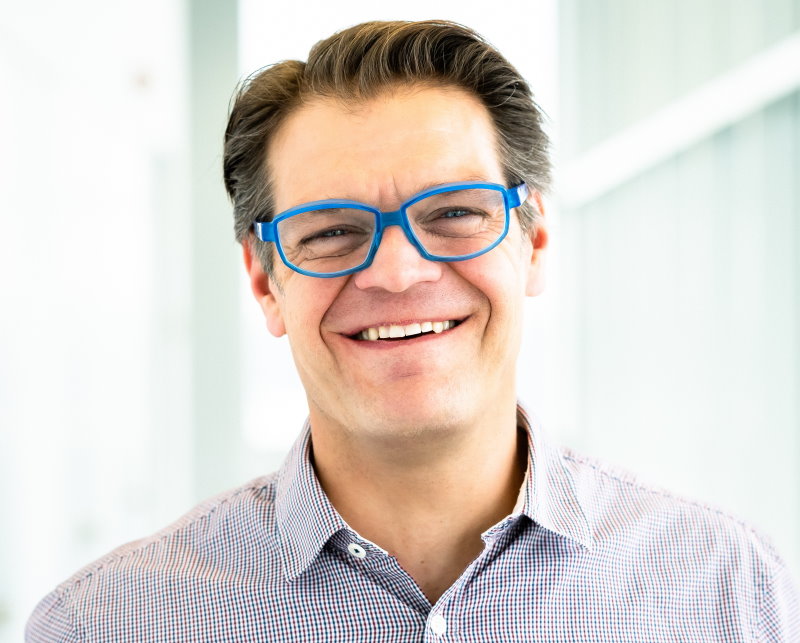
How a mechatronics course pushed the synchrotron community forward
When Curt Preissner took the “Mechatronics system design – part 1” course at High Tech Institute in Eindhoven, he was impressed by the local expertise but also the number of bikes riding around. “I bike to work here in the United States, but it’s not at all like in the Netherlands,” he looks back fondly.
Preissner is a mechanical engineer at the Advanced Photon Source (APS), a US Department of Energy (DOE) Office of Science user facility at DOE’s Argonne National Laboratory in Illinois. This synchrotron, a type of circular particle accelerator, generates radiation in the form of X-rays. These X-rays in turn can be used to make images of the nanostructure of materials, for example. Preissner is designing a very specific component for that system.
“In a particle accelerator, you accelerate electrons with the use of radio-frequency energy,” Preissner explains. “They then oscillate back and forth between the north and south poles of magnets, which produces what we call synchrotron radiation. In our machine, that radiation is in the form of X-rays. The energy of the X-rays we produce ranges from a few keV all the way up to 100 keV, so it’s highly penetrating. We take those X-rays and use something called a monochromator to select a particular wavelength. The instrument I’m designing is an X-ray microscope called the Ptychoprobe. This will be a unique, world-class instrument that focuses the X-rays down to five nanometers, something that doesn’t exist right now. So it will be a world’s first. The X-rays will be focused on the sample and diffract off of it. The diffracted X-rays from the sample will then be collected by a detector, from which we process the data to generate an image that shows the structure of the sample.”
Integrated approach
Preissner and his colleagues realized that this new design, which demands high degrees of precision, would require them to adopt a new engineering philosophy. “The specifications we work with can be very challenging,” he says. “Generally, our system is static. Yet, on the side of the beamline, things are moving. We have to scan our samples differently because the new beams are much more bright. This brightness will allow us to see our samples in greater detail. However, the high photon flux can actually damage the sample and prevent us from seeing these details. So, we want to do this quickly. We don’t need to work as fast as some semiconductor manufacturing equipment. We scan around seven millimeters per second – not an extremely high velocity. But for what we’re used to, this is quite high. The sample and the X-ray lens, called the zone plate, also need to maintain registration in the order of 1.25 nanometres. That’s pretty tight. We do that over length scales of about 10 millimeters. This is new territory for us, which is why we’re looking for new engineering approaches.”
After some research, they realized that mechatronics could offer an answer. “We first started in the synchrotron community,” explains Preissner. “There are a countable number of synchrotron instrumentation engineers, probably around a few hundred, less than a few thousand for sure. The community isn’t that big. So, when we didn’t find the answers we were looking for, we started researching other fields with similar performance specifications. This is how we ended up with semiconductor manufacturing equipment, and in turn the mechatronics approach.”

This approach, while common in some fields, is new in the synchrotron community. Mechatronics, however, might be what they need to keep pushing the technology forward. “In the last generation of instruments, 10-15 years ago, it wasn’t uncommon for a mechanical engineer to sit down with a beamline scientist and just design the mechanics, connect a motion controller, maybe some interferometry, and achieve results that got the scientific job done. The only consideration to dynamics in the design was vibrations, and there was certainly no system-level approach,” says Preissner. “But now the advancements in the accelerator and X-ray optics technology are really forcing us to push the limits of what we can do. That old approach will not work. We need to look ahead; science doesn’t allow us to stand still. The instrument I’m designing will need to be scientifically productive for at least the next ten years. A mechatronic approach is very interesting here. It’s great to think about things like error budgeting and dynamic models from the get-go. It’s a more integrated approach.”
Short timeframe
That’s how Preissner and a colleague ended up in the Netherlands taking a mechatronics course at High Tech Institute. For them, it was the ideal way of being quickly submersed in the field. “At the APS, we don’t always have the luxury to be able to do a huge amount of R&D,” Preissner notes. “We’re in a time crunch with this project. We need to gain knowledge fast, so we can work with vendors or do our own design. If you look at the wafer scanners of ASML, for example, their performance is very impressive. But an important thing to remember is that there are roughly forty years of development behind them. When we’re designing these instruments, we don’t have that time. We need to learn as fast as possible.”
One important thing they learned in the course was a new type of language, which allows them to better speak to their vendors. “We’re not just going out and buying something,” Preissner points out. “We’re proposing things and deciding whether a vendor can make certain designs. So knowing techniques like error budgeting is important, besides being able to look at designs with a mechatronics view. Getting some formal training accelerated our ability to talk to vendors. Certain key issues in this design keep me up at night, and we need to be able to communicate that. After the course, I could go to a vendor and ask them to, for example, show us their error budget. Or I could talk to them about the controller dynamics overlaid with the dynamics of the mechanics.”
The course taught them this in a short timeframe. This is important for an engineer like Preissner, who’s working on a time-sensitive project for a government-funded organization. “We’re under a high amount of pressure, so we were eager to learn, and did so quite fast. We looked hard for a course that could quickly package this knowledge for us. The APS is also a government institution, so we’re using tax dollars. We need to be mindful of how we spend them. We’re always looking at ways to achieve goals effectively, and this course taught us what we needed to know very efficiently.”
All of this is a work in progress according to Preissner. “The synchrotron engineering community has been operating in a certain way for a long time. But now people realize that we need to do things differently. This course enabled us to take that different approach.”
More courses
So far, the new mechatronics knowledge has mainly been used in contact with vendors. But Preissner notes that going forward, they want to also use it to design new instruments from the ground up. “It’s on the drawing board,” he says. “We’re wondering if we can take this new approach and apply it more systematically. Can we model the instrument, the control system model and the influences in a holistic way? What knobs do we need to turn? What control approach would make sense?”
For now, however, Preissner and his colleagues want to expand their knowledge of mechatronics. They’re already looking forward to taking more courses. “If you don’t use it, you lose it. So we’re feeling some pressure to apply what we learned as regularly as possible. The first part of the training was good, and now we’re thinking about taking additional courses. When you learn new engineering techniques, it takes a bit of time. You have to work with it. It has already changed our vendor interactions. The next step will be changing our own designs from the ground up.”
This article was written in close collaboration with High Tech Institute. Main picture credit: Mark Lopez/Argonne National Laboratory





